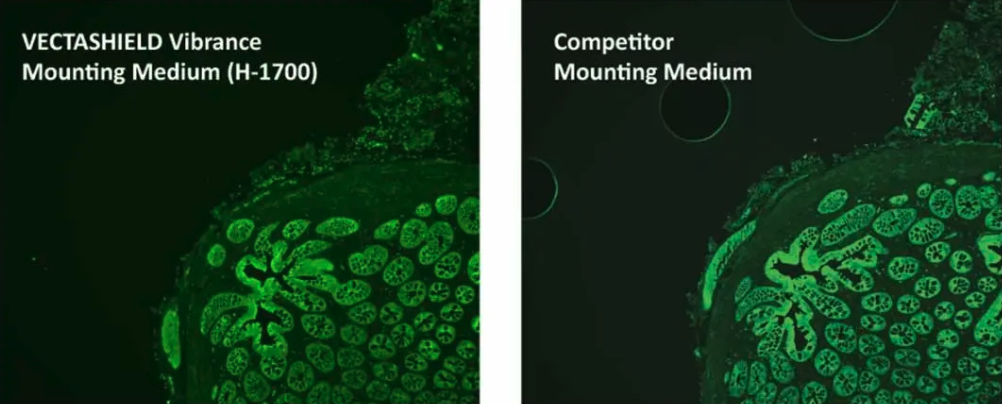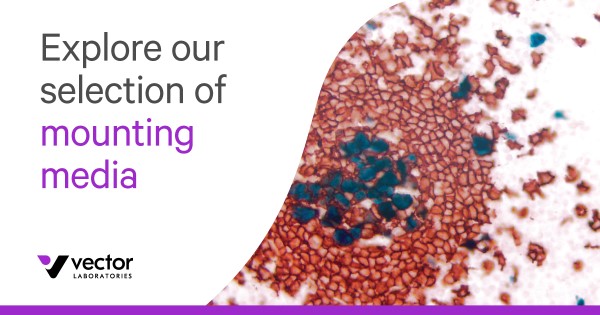Selection of mounting media for IHC or IF applications
What’s the Purpose of Mounting Media?
Mounting media adhere your specimen to a glass slide and coverslip, and in doing so, provide a protective benefit to your sample. Some mounting media have been developed with additional benefits including:
- To prevent cells from drying out
- To prevent signals from fading or photobleaching
- To preserve specimens for short or long-term storage
- To improve the optical clarity of samples when viewed under the microscope
- What are the Different Types of Mounting Media?
Mounting media can be classified as:
- Liquid mounting media, such as aqueous glycerol and lactophenol-based fluid media
- Solidifying (or semi-solid) media, including natural and synthetic gums and resins
- Water-soluble mounting media (e.g., glycerol-gelatin and gum-chloral)
- Partially water-tolerant mounting media (e.g., Euparal)
- Hydrocarbon-soluble mounting media (e.g., neutral Canada balsam)
Which Mounting Medium Should I Choose?
Choosing the ideal mounting medium for your application will require that you identify what is most important to you. Areas of consideration might be the length of time for which you intend to protect and store your sample. Or perhaps it might be whether any chemical incompatibilities exist between your sample type and the solvents of the mounting medium.
Considerations when choosing Mounting Medium should include:
The Application:
Immunohistochemistry (IHC) or light microscopy applications: Use a colorless mounting medium, like our clear-dry VectaMount Mounting Medium.
Immunofluorescence (IF) applications: Use a medium that protects the fluorescent signal with antifade, anti-photobleaching properties, like our VECTASHIELD PLUS Antifade Mounting Media.
Optical Clarity
For maximum clarity, detail, and contrast, the refractive index (RI) of the mounting medium should be close to that of glass (1.5) or the sample’s fixed/dried protein layers (1.53).
VectaMount has an RI of 1.49 when dry and VECTASHIELD mounting media has an RI of ~ 1.45 – both superior to other commonly used reagents (e.g. Fluoromout-G has a refractive index of ~ 1.40).
Permanence
For the long term storage of a specimen, the use of a hardsetting medium is recommended.
For IHC applications, we recommend VectaMount Mounting Medium. It has an RI of 1.49 when dry and is ideal for IHC applications.
For IF applications, we recommend VECTASHIELD Vibrance. It has an ideal RI (~ 1.45), is easy to use, and eliminates the need for the sealing of coverslips.
Protection from oxidation, changes in pH, and other physical or chemical damage
Mounting media should resist microbial contamination, bubble formation, crystallization, shrinking, cracking, and deformation.
Samples mounted with VectaMount media can be safely stored at room temperature for at least two years.
VECTASHIELD Vibrance Mounting Medium shows no loss of signal intensity or sample integrity after weeks of storage at room temperature.
VECTASHIELD Vibrance Mounting Medium reduces bubble formation and retraction vs. competito
Serial sections of human colon tissue (FFPE) mounted with either VECTASHIELD Vibrance Mounting Media with DAPI (H-1800, left image) or competitor mounting medium with DAPI (right image), each stored at room temperature for two weeks and then imaged. Sections of human (FFPE) stained for cytokeratin (AE1/AE3, mouse primary) followed by Alexa FluorTM 488 anti-mouse IgG secondary antibody. Sections were mounted with either VECTASHIELD Vobrance Mounting Medium (H-1700, left image) or competitor mounting medium (right image) stored at room temperature for two weeks, and then imaged.
Sections of human (FFPE) stained for cytokeratin (AE1/AE3, mouse primary) followed by Alexa FluorTM 488 anti-mouse IgG secondary antibody. Sections were mounted with either VECTASHIELD Vobrance Mounting Medium (H-1700, left image) or competitor mounting medium (right image) stored at room temperature for two weeks, and then imaged.

